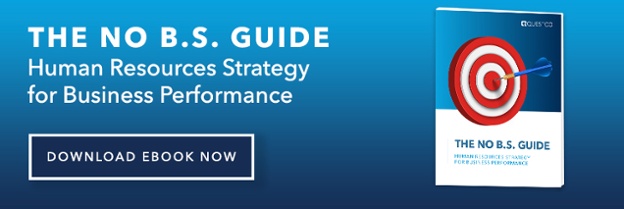Topic Business Performance,
Short Term vs Long Term HR Strategy: The Most Important Difference

September 21, 2020 | By Jason Randall

Companies and employees create short-term and long-term human resources goals to help track workplace progress and support business growth. To manage these challenges well, HR professionals must understand the difference between short-term and long-term goals. When your HR department uses the right approach, it’s prepared for immediate needs and future planning.
This article outlines the types of human resource strategies and how they differ.
What Is Strategic Human Resources Management?
Strategic Human Resources (HR) management means having a clear plan that explains how a company manages its people and supports their growth to meet organizational objectives. It aligns HR management practices with the overall business strategy and helps drive high performance.
An effective HR strategy usually includes talent management, training and development, compensation and benefits, employee relations, and company culture. It means knowing what the business and team members need, reviewing the current HR landscape, and applying solutions to close gaps or fix challenges.
Strong strategic plans in HR help attract top talent, improve employee feedback systems, and support work-life balance. They also ensure the workforce is aligned with company values and contributes to long-term competitive advantages.
What Is Short-Term HR Strategy?
A short-term HR strategy helps teams stay on top of daily responsibilities while solving issues. These are often unexpected challenges that require fast responses. Planning for these short-term HR goals prevents them from turning into long-term setbacks.
This kind of human resource planning includes immediate action steps that support the direction set by leadership. The SMART framework (Specific, Measurable, Actionable, Relevant, Time-based) is often used for this planning.
Examples of short-term HR goals include:
- Employee relations
- Staffing strategy
- Workforce management
- Retention programs
- Onboarding procedures
- Compensation structure
- Labor law compliance
What Is a Long-Term HR Strategy?
A long-term HR strategy focuses on preparing for challenges that could happen in the future—even if they’re uncertain today. Whether or not a problem is likely, having a strategy helps the team stay ready.
Long-term strategies often involve HR leaders and senior management agreeing on objectives that shape the future of the workforce. Once set, these goals typically don’t change frequently.
A great example is succession planning. Employees eventually leave, so a plan must be in place to fill roles quickly. Even if you're not hiring today, setting up a talent pipeline is a vital long-term HR goal.
Other examples of long-term HR goals include:
- Strengthening company culture
- Boosting employee engagement
- Building future HR technology systems
- Investing in leadership training
- Supporting career paths and long-term goals
When Long-Term Problems Become Short-Term Issues
A long-term HR goal becomes short-term when the issue is no longer theoretical. If a known issue becomes urgent, you need a strategy ready to go.
Take voluntary turnover. It’s a long-term concern until someone quits. At that point, the HR department must act fast to replace them. Without a plan, hiring delays lower productivity and slow the company down.
Even with notice, an HR team that’s not prepared can struggle. And in some cases, challenges like improving employee engagement or maintaining work-life balance may start as long-term concerns but require short-term action.
Why Separate Short- and Long-Term HR Strategies?
Separating short-term and long-term strategy makes planning clearer, even if you're building general HR strategies. Here's why:
Goal Setting
Short-term planning focuses on the present, while long-term planning supports future organizational objectives. Determining both helps you measure success and track progress.
Resource Allocation
Short-term goals often need fast support. Long-term strategies may require bigger investments of time, money, or tools like HR technology. Knowing the difference ensures better resource use.
Risk Management
Short-term plans carry less risk. Long-term ones come with uncertainty. Breaking them apart helps teams prepare for what’s coming and build backup strategies.
Decision Making
Short-term issues require fast decisions based on limited data, while long-term ones demand deeper analysis. Planning for both helps HR make informed choices that support business growth.
Staying Flexible
Short-term strategies require agility. Long-term ones provide structure. Knowing how to shift between them helps HR stay resilient during change.
Build Human Resource Strategies for Every Situation
You don’t always need to split every plan into short- and long-term categories. But when you do, you’ll see problems from different angles, build more innovative solutions, and use your time and energy better. With a straightforward approach to human resource planning, HR professionals can improve team member experience, support growth, and keep strategy aligned—no matter what comes next.
.jpg)
Jason Randall
Jason L. Randall is the CEO of The Questco Companies. He regularly speaks on topics related to strategy, growth, and organizational performance.




